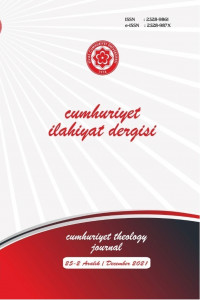COVID-19 Pandemisi Sürecinde Dinî Gruplarda Otantikliği Yitirme Korkusuna Dayanan Yüz Yüze Etkileşim ve Ritüel Israrı: Delhi ve Kum Vakaları
Insistence on Face-to-face Interaction and Ritual Based on Fear of Losing Authenticity in Religious Groups During the COVID-19 Pandemic: The Cases of Delhi and Qom
Author(s): Bayram SevinçSubject(s): Islam studies, Health and medicine and law, Sociology of Religion
Published by: Cumhuriyet Üniversitesi İlahyat Fakültesi
Keywords: Sociology of Religion; Tablīghī Djamā‘at; Nizamuddin Markaz; COVID-19; Shiism;
Summary/Abstract: At the present time, when we are experiencing one of the extraordinary conditions in which the basics of life are shaken, exceptional practices concerning the sources of the meaning of the world of life have become one of the urgent issues for the sociology of religion to consider. This study discusses the reactions of people to the effects of the COVID-19 pandemic on the regularity of social life in the early stages in the framework of Muslim religious groups. Since the forms of social organization reveal reactions in their own specific forms, a research design that considers the differences were preferred. The provision that ‘man is social by nature,’ which is the indispensable principle of social sciences, has been the main feature of important issues to elaborate in the restrictions of today’s pandemic. Religious socialization, which is important for the inquiry, is a phenomenon that is desired to be carried out on a continuous basis. Its performative dimension draws attention to important elements that affect the formation and the social ontology of the group, such as consciousness and solidarity. While some religious groups insist on face-to-face interaction and rituals, some of them prefer to use effectively digital tools and channels. This differing approach has become a public issue, especially during the pandemic process. On the other hand, there is a discussion in the context of the digital world of new media tools and the travel possibilities of transportation technology. The theoretical basis of this study, which deals with the insistence of religious groups on face-to-face interaction and rituals is represented from the scope of Erving Goffman. His analyzes face-to-face communication and his comments emphasizing the ritualistic nature of daily life are operationalized through two basic case studies: the first case is the persistence and practice of Tablīghī Djamā‘at, in its annual meetings in the early days of the pandemic. The discussion started with the practice of the religious group in Delhi (Nizamuddin Markaz), since they did not cancel their annual meeting despite the diagnosis of the disease. The second case is based on the ritual insistence of pilgrims in visiting shrines in the Iranian city of Qom. The insistence of the Shiite Islamic understanding on ritual and pilgrimage and the solidarity built with the consciousness based on it is a well-known phenomenon. In the Covid-19 pandemic, the risk of contamination caused by the mobility of the pilgrims coming to the city of Qom from countries such as Pakistan was discussed, as well as the contact and social distance during the Hajj. Two cases were handled with a qualitative design including case analysis method and descriptive analysis technique. The main purpose and intended contribution of the article are to reveal the insistence of face-to-face interaction through the performative based on rituals as an analytical explanatory on the social level. Inferences based on the analysis of religious groups’ response to restrictions in times of emergency build the importance of the issue. Case information identified in the context of the case study shows that groups with traditional interaction forms insist on their own practice in the field of uncertainty and initiative. Unless necessity eliminates the initiative, the determination of this insistence of traditional religious groups is not only theological but also ontological confirmation. It is understood that the members of the group took the initiative to represent their reputation within the group and their extent to dedicate to the group. The fact that Tablīghī Djamā‘at, the largest group of the transnational Islamic da‘wa (call), did not give up on a method based on demographic mobility, has been a matter of discussion. The insistence of the group is because of the methods that require every ordinary believer to accept to convey the da‘wa as his primary duty. On the other hand, Shiism, which stands out with its traditional structure and ritual intensity in the Islamic world, insisted on the initiative process in the pilgrimage phenomenon, on which it attached special importance and built its solidarity and identity on this phenomenon. This insistence aims preserving the dynamics and social ontology of the religious group in the performance of the membership system. Essentially, the individual in the group insists on his position in face-to-face interaction because having a role in a group also means having a face. Thus, this insistence performance by religious groups should also be read as a reflection of self-technologies. In the final analysis, the insistence put forward should be considered essentially in relation to the insistence on the position in social ontology.
Journal: Cumhuriyet İlahiyat Dergisi
- Issue Year: 25/2021
- Issue No: 2
- Page Range: 641-660
- Page Count: 20
- Language: Turkish

